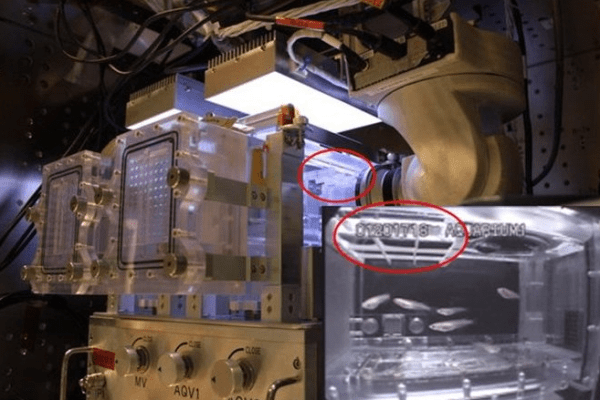Caption: The Aquatic Habitat will enable the study of fish aboard the International Space Station. Credit: JAXA.
How does microgravity impact marine life? One of the more unique experiments on board the Japanese HTV-3 supply ship, scheduled to be berthed to the International Space Station's Harmony node at 12:00 UTC on July 27, 2012, is the Aquatic Habitat, or AQH. It is basically an aquarium designed to function in space, complete with fish called Medaka. While there are several experiments planned for the AQH, surely the astronauts will enjoy watching their newest "pets" on the ISS.
Sponsored by the Japanese Space Agency, or JAXA, the AQH is a closed-water circulatory system, which provides a new facility option for station research. Scientists will use the habitat to study small, freshwater fish on orbit, the Medaka (Oryzias latipes).
This is not the first time fish have been part of a space mission. Versions of the AQH flew on space shuttle missions STS-47, STS-65, and STS-90. The current system's design upgrades are based on lessons learned from these missions.
Scientists have multiple studies planned to look at the impacts of radiation, bone degradation, muscle atrophy, and developmental biology. The investigations could last up to 90 days and provide data that may lead to a better understanding of related human health concerns here on Earth.
"We think studies on bone degradation mechanisms and muscle atrophy mechanisms are applicable to human health problems, especially for the aging society," said Nobuyoshi Fujimoto, associate senior engineer at JAXA's Space Environment Unitization Center.
Fujimotoe said the Medaka fish are ideal specimens for many reasons. They are transparent, making it easy to view the inner workings of their organs. They also breed quickly and easily in microgravity environments, enabling multi-generation studies. Researchers can take advantage of a variety of genetic modifications to these fish, as well. Finally, scientists already have all of the Medaka genome identified, which makes it easier to recognize any alterations to the fishes' genes, due to factors like space radiation.
The AQH will reside in the Japanese Experiment Module, or JEM, which is also known as Kibo, or "hope" in Japanese. It will attach to a multipurpose small payload rack for power and housing.
This habitat will provide automatic feeding for the fish, air-water interface, temperature control, and a specimen sampling mechanism. There will be two chambers for habitation, each sized at 15 by 7 by 7 cm, holding about 700 cc water and a stabilized area for oxygen that will enable fish to "peck" air. LED lights will simulate day and night cycles, while two video cameras record images of the fish to downlink to the ground, upon request.
This facility includes an improved water circulation system that monitors water conditions, removing waste while ensuring proper pressure and oxygen flow rates.
"In order to keep water quality in good condition for the health of the fish, we had to do many tests on the filtration system, especially the bacteria filter," said Fujimoto. "The special bacteria filter purifies waste materials, such as ammonia, so that we can keep fish for up to 90 days. This capability will make it possible for egg-to-egg breeding aboard station, which means up to three generations may be born in orbit. This would be a first for fish in space."
Hopefully the crew will enjoy viewing and monitoring the fish, and those of us on Earth look forward to some live views of the fish in microgravity.
Source:
NASA
 Universe Today
Universe Today
